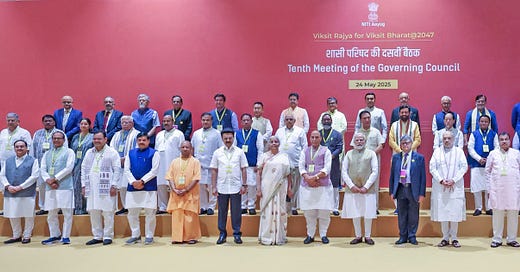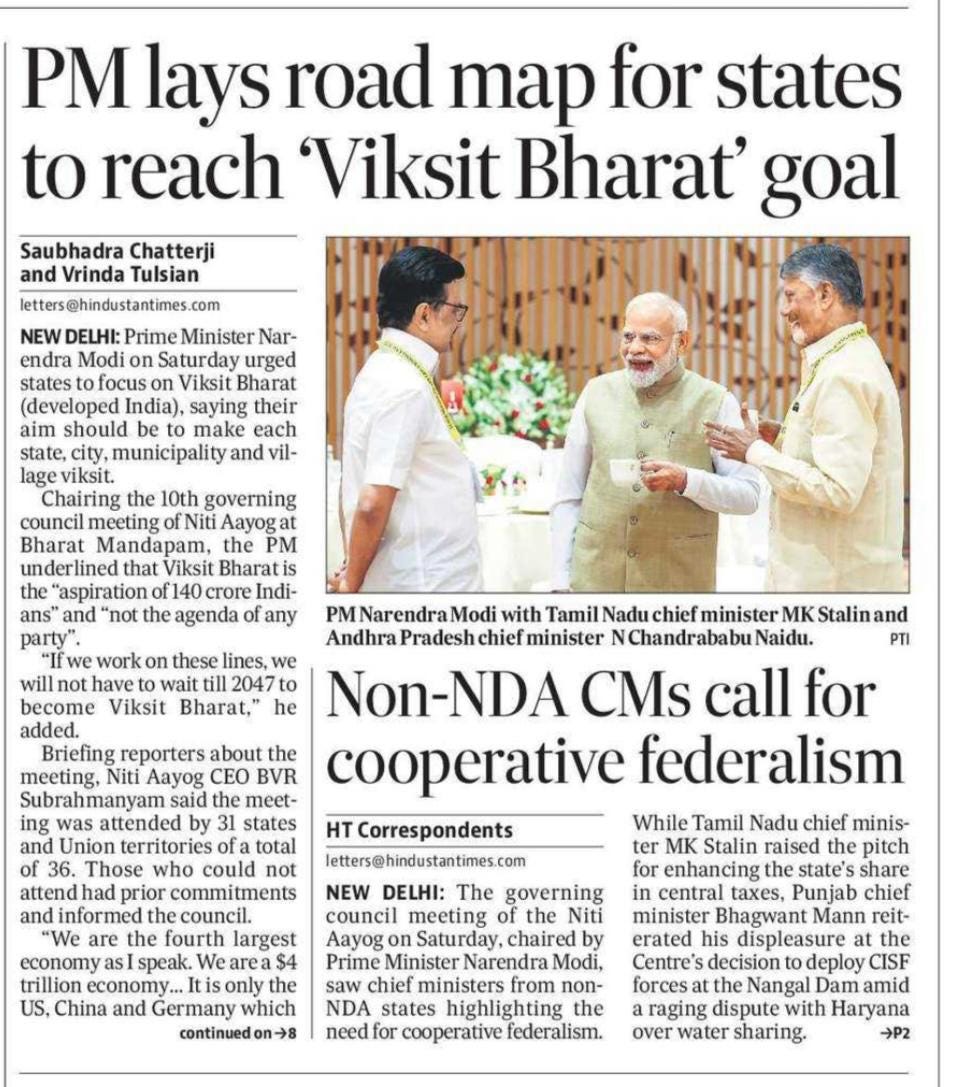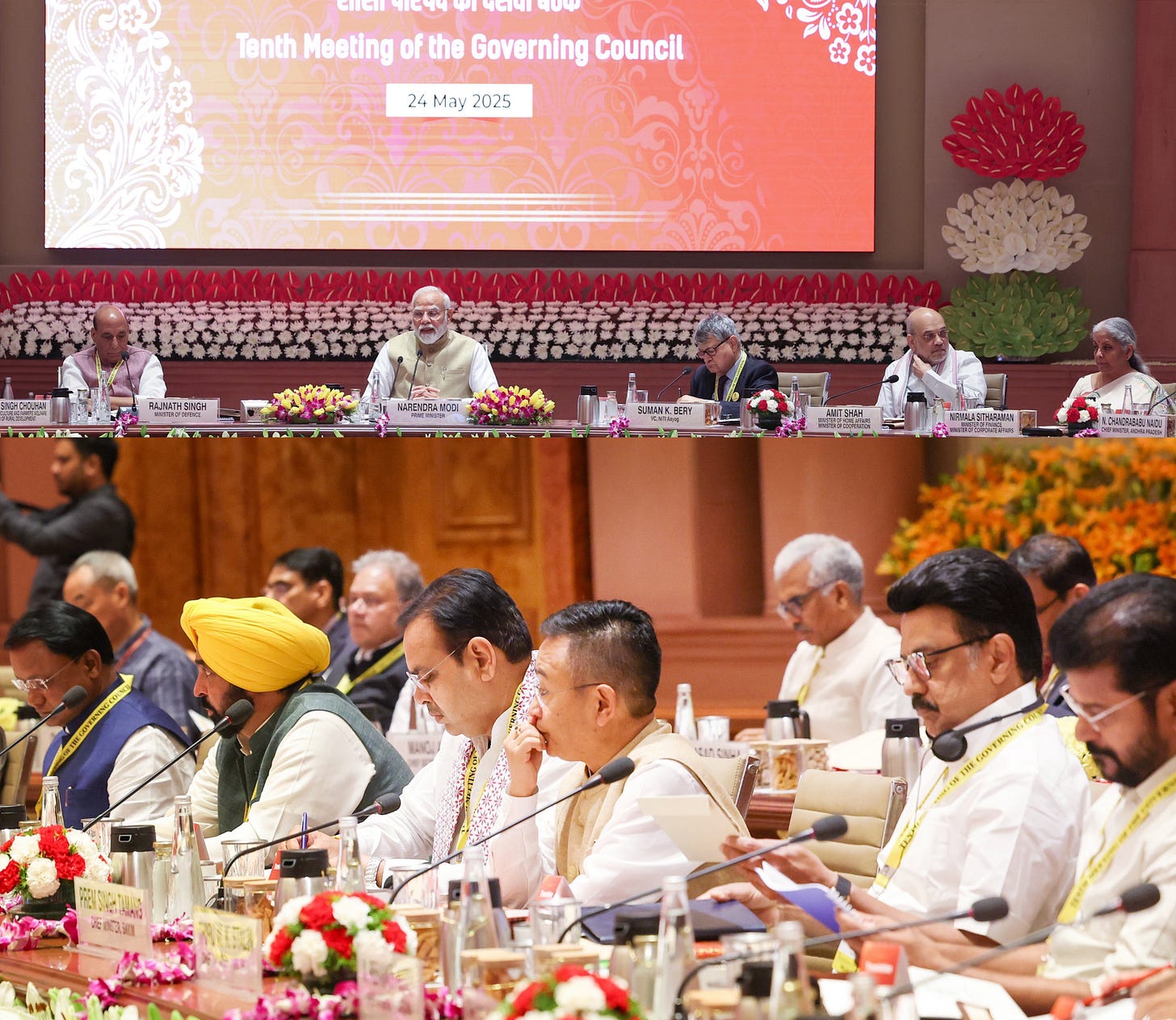The Goal of 'Viksit Bharat' 2047: A National Dream or a Mere Mirage
Defining the Vision: The Imperative for Precision in India's Development Aspirations Beyond Infrastructure and Economic Metrics.
By Karan Bir Singh Sidhu
Retired IAS Officer, Former Special Chief Secretary, Punjab.
Public policy commentator with nearly four decades of experience in the Indian Administrative Service, specialising in governance, development economics, constitutional law, and minority rights.
The Goal of ‘Viksit Bharat’ 2047: A Daring Dream or a Mere Mirage
In the 10th meeting of the Governing Council of NITI Aayog held on Saturday, 24th May, the Prime Minister called for the cooperation of all Chief Ministers to achieve the goal of Viksit Bharat by the year 2047, accentuating that this ambitious vision cannot be realised without the spirit of cooperative federalism. While India's economic trajectory since 2010 has been remarkable—with GDP growing from $1.68 trillion in 2010 to $3.57 trillion in 2023, representing more than a doubling of economic output—the fundamental question remains whether this quantitative growth translates into qualitative development that benefits the vast majority of Indian citizens. The challenge lies not merely in achieving impressive macroeconomic indicators but in ensuring that the fruits of this growth reach beyond a minuscule elite to transform the lives of ordinary people who continue to struggle with poverty and inequality.
The Evolution of Development Discourse in India
From ‘Unnati’ to ‘Viksit Bharat’: The Semantic Journey
Since our school days, we have been hearing vernacular equivalents of the word 'development', with each political era bringing its own terminology and interpretation. During the days of Mrs. Indira Gandhi, it was 'Unnati'; later, the term ‘Pragati’ gained currency; and today, Vikas and Viksit Bharat have become part of political parlance and central to the Modi Government's policy narrative, particularly pronounced in the third term of the administration. This semantic evolution reflects not just changing political vocabularies but also shifting conceptual frameworks about what development means for a diverse nation like India.
The concept of development itself remains contested and multifaceted, with no universally accepted definition emerging over time. Some scholars argue it is not merely a goal but a process—a journey rather than a destination. This raises a fundamental question that has profound implications for India's 2047 vision: is development merely political and economic rhetoric meant to engage citizens who are otherwise burdened by poor governance and weak economic conditions, or does it represent a substantive transformation in the quality of life for the masses?
Economic Growth Versus Inclusive Development
The GDP Growth Story Since 2010
India's economic performance since 2010 presents a compelling narrative of growth and expansion. The country's GDP has demonstrated remarkable resilience and growth, rising from approximately $1.68 trillion in 2010 to $3.57 trillion in 2023. This represents an average annual growth rate that has consistently outpaced many developed economies, with India maintaining its position as one of the fastest-growing major economies globally. The GDP growth rate averaged 6.42 percent from 2006 until 2025, reaching an all-time high of 9.70 percent in 2022.
However, a more nuanced examination reveals concerning patterns when these aggregate figures are disaggregated. While India aspires to become a $5 trillion economy, the pertinent question often overlooked is whether this aspiration translates into rising per capita income for the average Indian. The GDP per capita figures tell a more sobering story: despite the impressive aggregate growth, India's per capita income has grown from $1,235 in 2010 to $2,236 in 2023. While this represents an 81% increase over thirteen years, India still ranks 136th globally by GDP per capita (nominal), highlighting the vast gap between aggregate economic performance and individual prosperity.
The Challenge of Per Capita Income Distribution
The critical issue lies in the distribution of this economic growth across India's vast population. A minuscule elite with astronomical incomes can skew GDP figures upwards, but what becomes of the teeming millions who live on the edge of poverty, surviving not month-to-month, but day-to-day, on meagre wages? This concern is validated by international comparisons that show India's GDP per capita PPP at $9,160 in 2023, which while higher than the nominal figure, still places India far below the global average for developed nations.
The economy of India, characterised as a developing mixed economy, is the world's fourth-largest by nominal GDP and third-largest by purchasing power parity, yet on a per capita income basis, India ranked 136th by GDP (nominal) and 119th by GDP (PPP). This stark contrast between aggregate economic size and individual prosperity underscores the fundamental challenge in achieving truly inclusive development.
Infrastructure Development and Its Limitations
Beyond Physical Infrastructure
The prevailing narrative of development often equates progress with physical infrastructure—superb roads, swanky airports, bullet trains, state-of-the-art ports, and digital infrastructure. While these developments are impressive and necessary for economic competitiveness, they represent only one dimension of comprehensive development. Unless the underlying principles of equity and mass welfare are delivered to the last citizen—or at least 90% of its 140 crore-strong population—India cannot, in all fairness, call itself a Viksit Bharat.
Nearly 70% of India's GDP is driven by domestic consumption, making the country the world's fourth-largest consumer market. However, this consumption is heavily skewed toward urban, affluent populations, while rural and economically disadvantaged groups remain marginalised from the benefits of economic growth. The services sector, which accounts for more than 60% of GDP, employs a relatively small fraction of India's workforce compared to agriculture, which constitutes around 12% of output but employs more than 50% of the labour force.
Health, Education and Nutrition: Pillars of Human Development
A truly Viksit Bharat cannot rest on infrastructure and macro-economic achievement alone; it must deliver affordable, high-quality health care, universal education, and adequate nutrition to every citizen. Schemes such as Ayushman Bharat—which promises health-insurance cover to the poorest households—and the ongoing Public Distribution System that currently provides free food-grains to nearly 800 million people are laudable safety nets, yet they are not sustainable as permanent substitutes for robust public services and dignified livelihoods. The long-term aspiration must be to ensure well-funded primary health centres, modernised government schools, and community-based nutrition programmes that eradicate stunting and anaemia, while gradually reducing dependence on perpetual grain subsidies. Embedding these human-development goals at the core of the Viksit Bharat 2047 agenda will transform demographic potential into productive capability and guarantee that economic progress is matched by genuine improvements in the well-being of every Indian.
Fiscal Policy and Social Equity Concerns
The GST Burden and Income Distribution
The implementation of the Goods and Services Tax (GST) exemplifies the challenges of achieving equitable development through fiscal policy. As an indirect tax, GST impacts both rich and poor alike, but its regressive nature disproportionately affects lower-income groups. The argument that luxury goods carry higher GST rates and hence impact only the affluent rings hollow, as such purchases are often made through corporate entities which then benefit from depreciation, interest deductions, and access to borrowed funds.
The disproportionate burden of GST on the bottom half of the income pyramid is undeniable and demands redress. This fiscal structure contradicts the principles of progressive taxation that are essential for reducing inequality and ensuring that economic growth benefits all segments of society rather than exacerbating existing disparities.
Corporate Tax Advantages and Small Enterprise Disadvantages
Even in direct taxation, India presents unique contradictions that undermine equitable development. The highest marginal income tax rate for individuals is often greater than the tax rates applicable to companies, particularly startups, which may be taxed at 15%—not to mention the many incentives they receive from central and state governments. A small shopkeeper or entrepreneur cannot easily incorporate themselves to avail such benefits, creating an uneven playing field that favours large corporate entities over small and medium enterprises.
This tax structure raises fundamental questions about India's commitment to inclusive growth and suggests the need for rationalising and converging tax rates across the board so that small and medium taxpayers are not unfairly penalised compared to well-funded corporate entities.
Institutional Challenges and the Rule of Law
Banking and Debt Resolution Disparities
The Indian bankruptcy code and debt resolution framework reveal stark inequalities in how different segments of society are treated under the law. Numerous instances exist where public sector banks and banking consortiums have agreed to debt resolutions that write off as much as 90% of outstanding loans, ostensibly to preserve existing enterprises. Often, the same delinquent promoters or lenders re-acquire these businesses under different legal entities, amounting to little more than legalised looting of public funds.
In stark contrast, small borrowers—farmers, landless labourers—face harsh recovery measures under colonial-era laws. They may be imprisoned for up to 40 days for defaulting on petty sums, and agricultural land, including standing crops, can be attached and sold. This disparity is indefensible in any vision of a developed India and represents a fundamental failure of institutional equity.
The Myth of Trickle-Down Economics
The long-promoted theory of trickle-down economics has shown limited empirical evidence of effectiveness in the Indian context. Rather than reaching the grassroots, the benefits of growth either evaporate through systemic leakages or are captured by intermediaries. Despite the advent of direct benefit transfers, only a fraction of generated wealth actually trickles down to those who need it most.
This failure of trickle-down mechanisms necessitates a fundamental reconsideration of development strategies and a renewed focus on the Directive Principles of State Policy, which, while non-justiciable, should guide the developmental agenda and shape policy and budgets if the goal of achieving Viksit Bharat by 2047 is to be more than a hollow catchphrase.
Constitutional Values and Social Justice
Ensuring Justice Through Equitable and Inclusive Reform
The Indian Constitution grants fundamental cultural and educational rights to minorities—religious and linguistic—under Articles 29 and 30. This provision is both laudable and essential, representing India's deep-rooted commitment to pluralism and diversity. However, it is equally important that the pursuit of equality does not result in the perception or reality of differential treatment—whether for the majority or any minority community.
In this context, it is vital to ensure that recent legislative and policy initiatives—including the abolition of triple talaq, the proposed Uniform Civil Code (UCC), the enactment of new Waqf-related laws, and the Citizenship (Amendment) Act (CAA)—do not inadvertently send a message that India's largest minority community, the Muslims, with a population of around 20 crore, is being singled out for reform or scrutiny under the guise of socio-economic modernisation.
While each of these measures may be defended as steps towards gender justice, uniformity, or national integration, their cumulative impact must be examined in light of the constitutional promise of equality before the law and protection of cultural rights. A state-led reform process that appears selectively targeted risks eroding trust and may give rise to fears of institutionalised discrimination—especially if it is not accompanied by broad-based consultation, transparent rationale, and uniformly applied standards across all communities.
India’s strength lies in its ability to accommodate multiple identities within a democratic framework. Therefore, reform must be rooted in justice, fairness, and dialogue, rather than perceived imposition. The rule of law must apply equally and uniformly to all citizens, irrespective of religious, linguistic, or cultural affiliation. Anything less undermines the spirit of the Constitution and weakens the social fabric of the Republic.
Reassessing Reservation Policies
Reservation, though an enabling provision rather than a fundamental right, has been a cornerstone of social justice in India. However, there is a growing need to reassess whether entrenched beneficiaries—castes or families who have received significant advantages for generations—should continue to avail of these benefits while more deserving groups are left out. The recent Supreme Court judgment allowing intra-caste gradation among Scheduled Castes represents a step in this direction, and a national conversation is now warranted to embed this within the broader development agenda.
Democratic Governance and Citizen Participation
Beyond Electoral Democracy
India's survival as a diverse democracy since 15th August 1947, and more robustly since 26th January 1950, is nothing short of a miracle. However, this democratic spirit must permeate all levels—Panchayati Raj, urban local bodies, state legislatures, and Parliament. The proposal for 'One Nation, One Election' is commendable in principle, but it must not come at the cost of accountability.
Citizens must be trained not just to vote every five years but to remain informed, engaged participants in shaping public discourse and demanding transparency and performance. This requires a fundamental shift from passive citizenship to active civic engagement, where citizens hold their representatives accountable for delivering on development promises rather than merely accepting rhetoric.
Defining Success Metrics for Viksit Bharat
The Need for Precision in Development Goals
The vision of Viksit Bharat by 2047 requires precise definition, much like the United Nations did with its Sustainable Development Goals (SDGs). Without such specificity, the vision risks being reduced to a slogan—or worse, a bold political pronouncement that devolves into rhetoric, especially when filtered through the din of sensationalist television debates that generate more heat than light.
Current economic indicators, while impressive in aggregate terms, fail to capture the lived reality of millions of Indians. India's GDP growth has consistently outperformed many developed economies, with the economy expanding by 6.2% in the fourth quarter of 2024. However, this growth has not translated proportionally into improvements in per capita income or quality of life indicators for the majority of the population.
Constitutional Principles as Development Benchmarks
The Directive Principles of State Policy provide a constitutional framework for defining development success that goes beyond mere economic metrics. These principles emphasise social justice, economic welfare, and the dignity of the individual—values that must shape policy and budgets if Viksit Bharat is to represent genuine transformation rather than selective prosperity.
The vision must go beyond world-class infrastructure and ensure that more than a minuscule percentage of the population lives with dignity, comfort, and equity. The Preamble of the Constitution speaks of the unity and integrity of the nation, but it also upholds the dignity of the individual. Personal liberties, due process, freedom of speech, and an independent judiciary are non-negotiable pillars of a developed nation.
Summing Up and Looking Forward
The overarching objective of achieving Viksit Bharat—a century after India's independence and its tryst with destiny—is both inspiring and urgent. However, the path from aspiration to reality requires more than impressive GDP figures and gleaming infrastructure. While India's economic growth since 2010 has been remarkable, with GDP more than doubling from $1.68 trillion to $3.57 trillion, the per capita income growth from $1,235 to $2,236 over the same period reveals the limited impact on individual prosperity.
The Prime Minister's message was unequivocal: India must integrate equity, justice, and individual dignity into its national journey. This requires moving beyond the rhetoric of development to embrace substantive policy reforms that address taxation inequities, institutional biases, and the failure of trickle-down economics. When our children and grandchildren awaken on the morning of 15th August 2047, they should be proud not only of modern infrastructure but of an egalitarian society that values justice, fairness, and mutual respect.
That will be the true test of Viksit Bharat—a test that India must strive to pass not by default, but through conscious and collective effort led by all stakeholders (video), especially the citizenry. The goal of Viksit Bharat 2047 can transcend the realm of political rhetoric and become a lived reality only if it is grounded in precise definitions, measurable outcomes, and an unwavering commitment to inclusive development that leaves no Indian behind.







Thanks, Sir for this article. I have a lot of comments to offer. First few as below:
1. Comparison of a country like India with US, Europe is futile, they will never be same. India should not, and is not, pursuing a US type growth.
2. Per capita income may not be the right parameter for India where lowest level living unit is "family", not "individual".
3. We are a labor surplus nation, others are capital surplus. They can discard their machines if not needed, we can't discard our people.
4. Misinformation by govt before the rise of Social media has set wrong priorities among the people.
5. Our states have failed miserably to take ownership of anything, and have conveniently blamed centre for everything. All resources that contribute to development, namely, land, education, health, electricity, law and order are state subjects. But all states ask questions from Centre on unemployment.
6. GST doesn't affect rich and poor alike. Poor spend most on food, which is GST free. Lower middle class spends on food or on saving, both have no GST.
7. In a country of 1.4Bn, private sector is a critical player. In a global economy, if we want pvt sector investments, we have to give them tax incentives. Today we are consuming 70% of our own produce. If there are no incentives for pvt sector, we'll end up consuming 100% of produce imported from somewhere else.
8. Comparison of tax applicable to salaried class and entrepreneurs is weird. These are two different skill sets, two extremely different vocation, require different set of efforts - both physical and mental. Their contributions to society can't be measured by taxes alone.
9. Appeasement politics of certain sections of society have inflicted damage to the social fabric of the nation. Strange that correction of historical wrongs look targeted at one section. 130 odd prime properties in Delhi handed over to one section of society, hours before elections in 2014 - we should call that as a "targeted appeasement and vote bank politics". I am not against any section of society, but all must be treated equal.
10. Judicial system in India continues to be a joke. Judicial reforms are a must, sooner the govt realizes it better it is.
Overall: Viksit Bharat of 2047 may not look like United States, but, it must not look like today's India too.
Regards